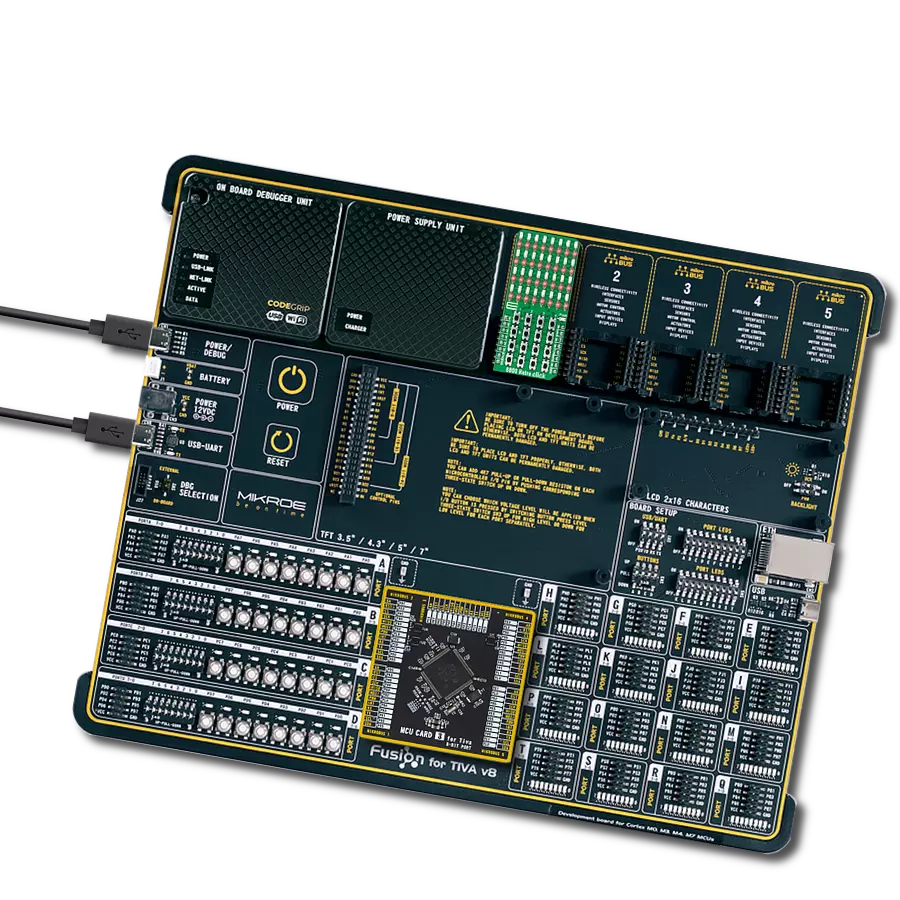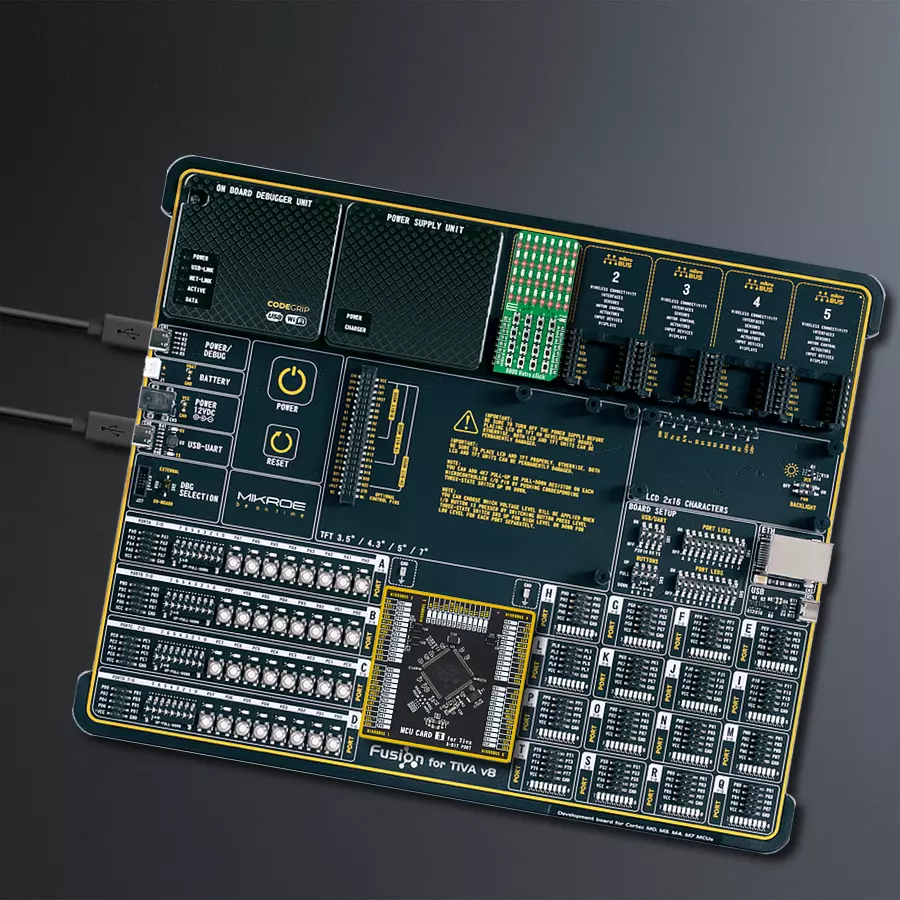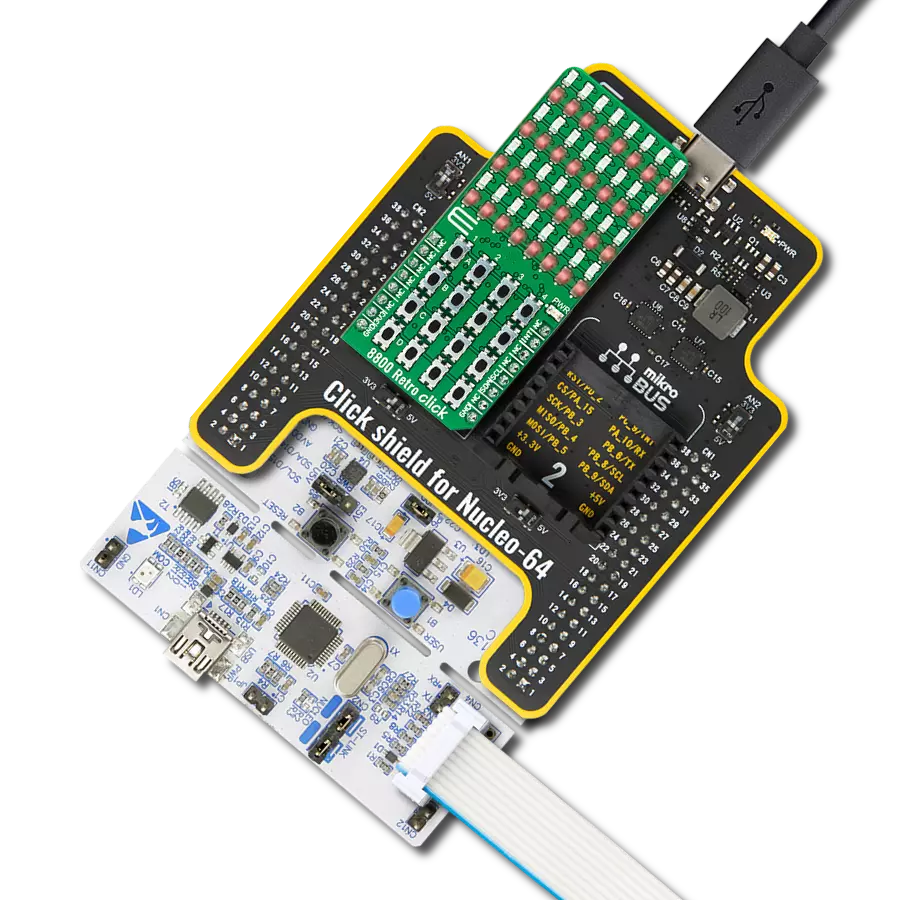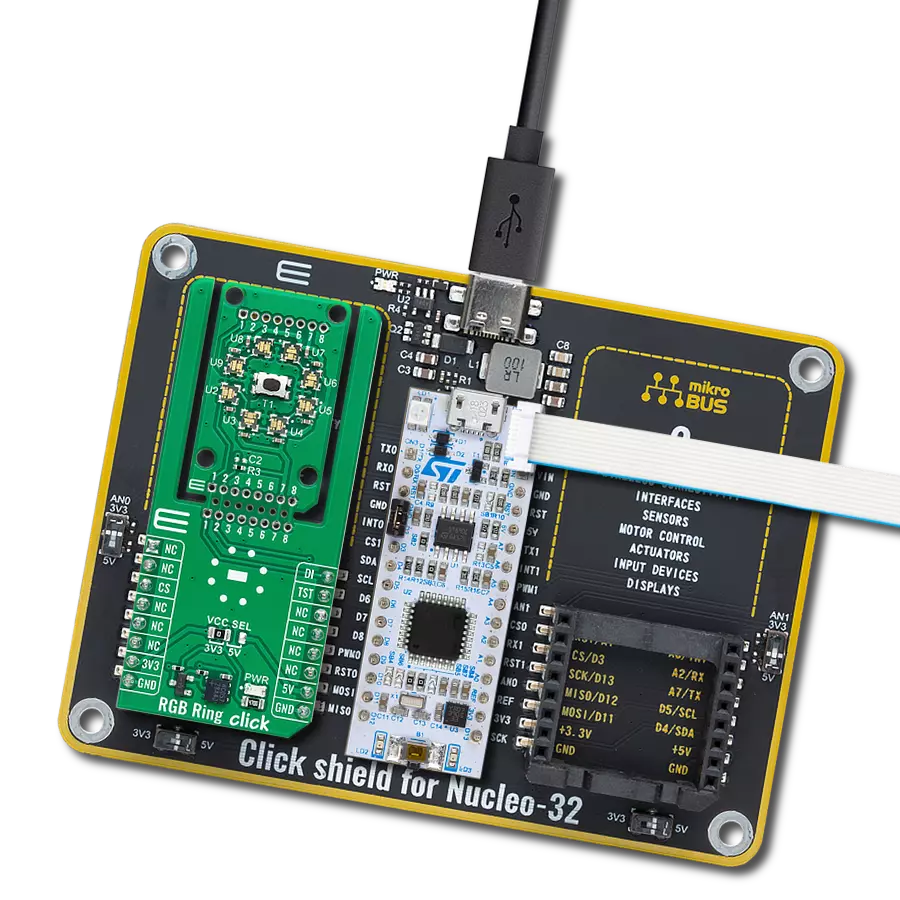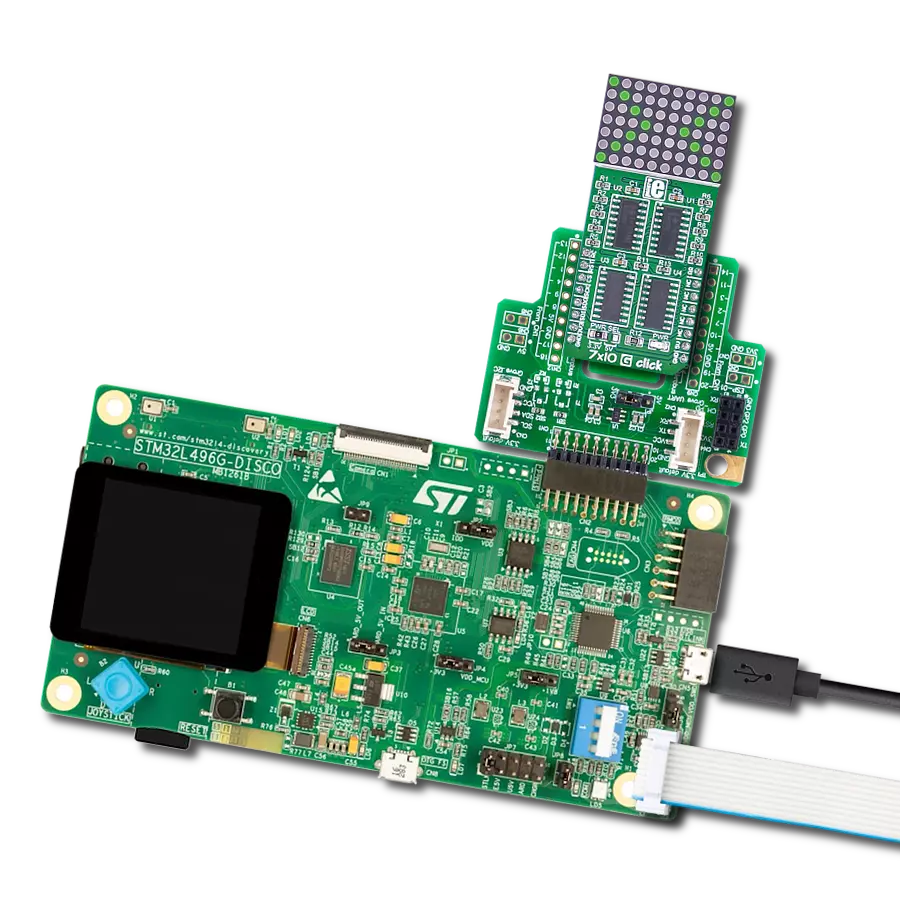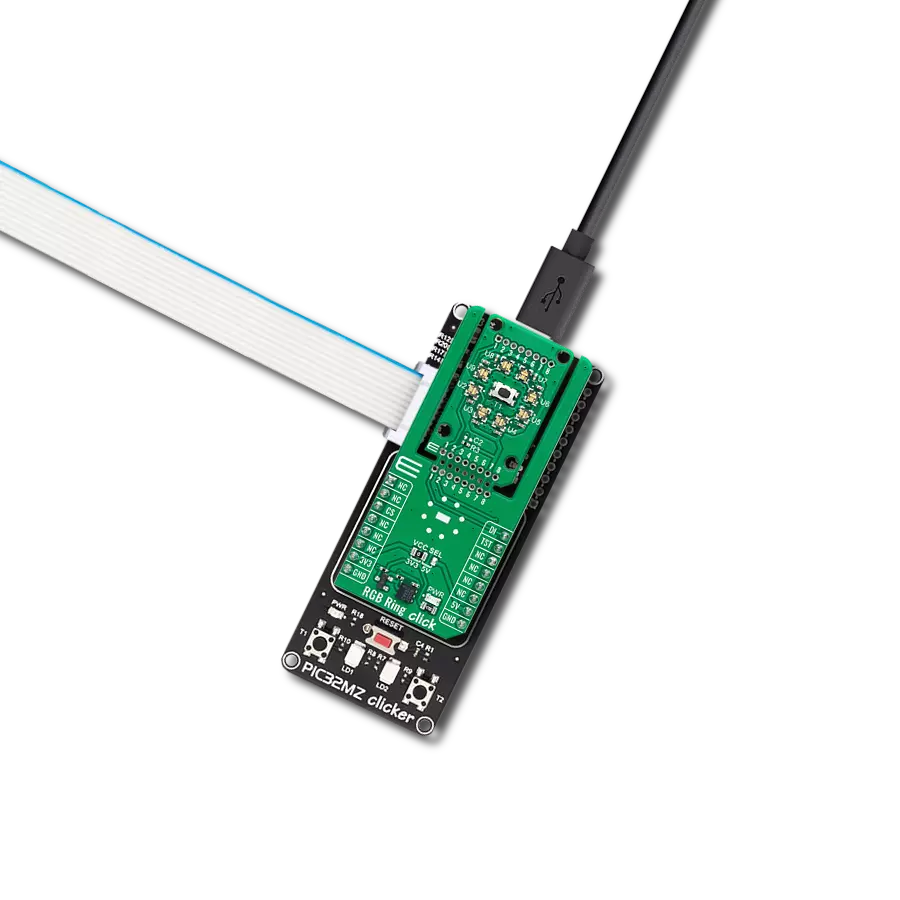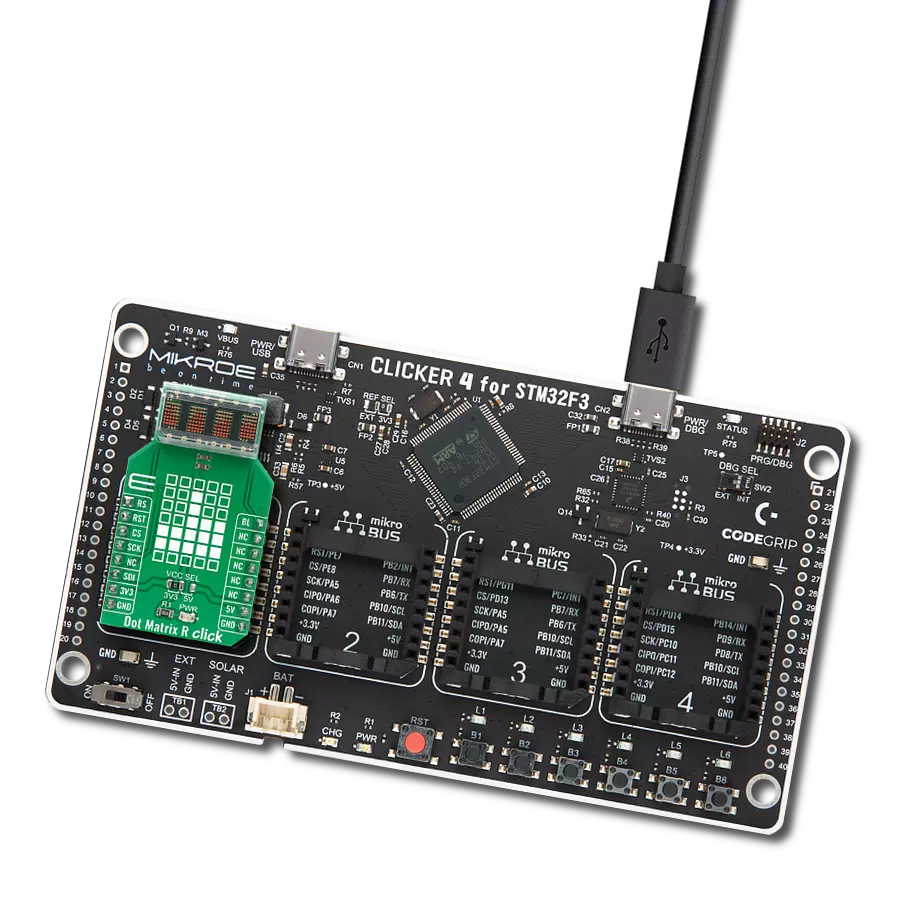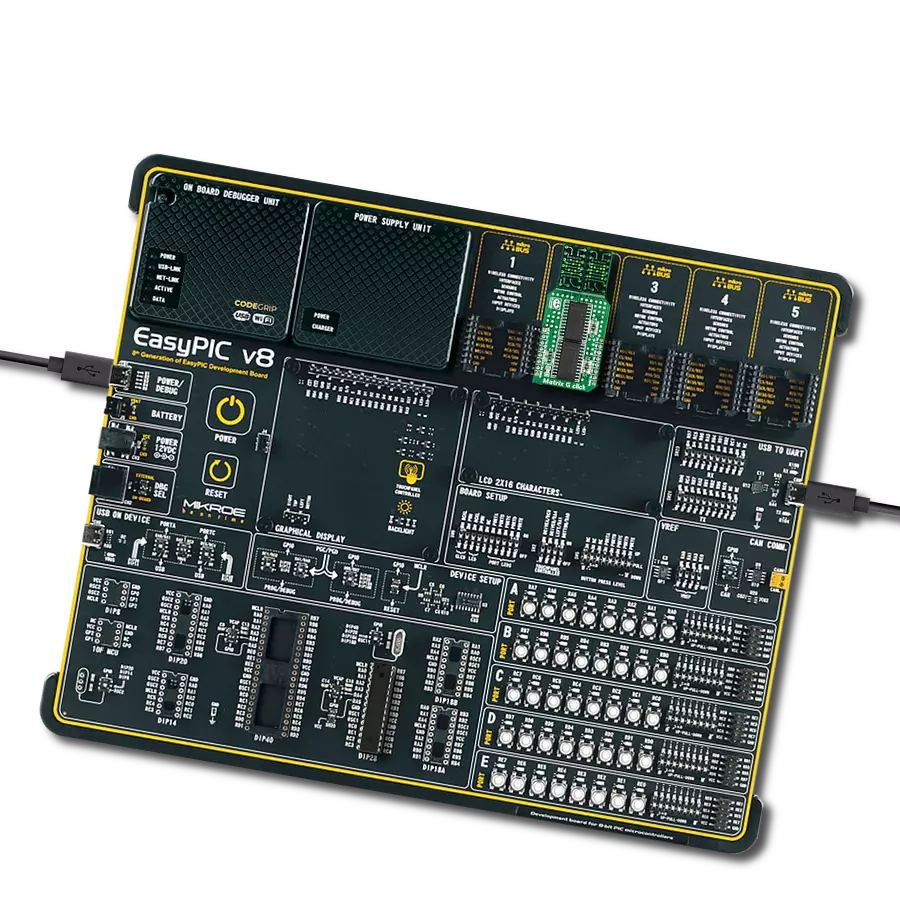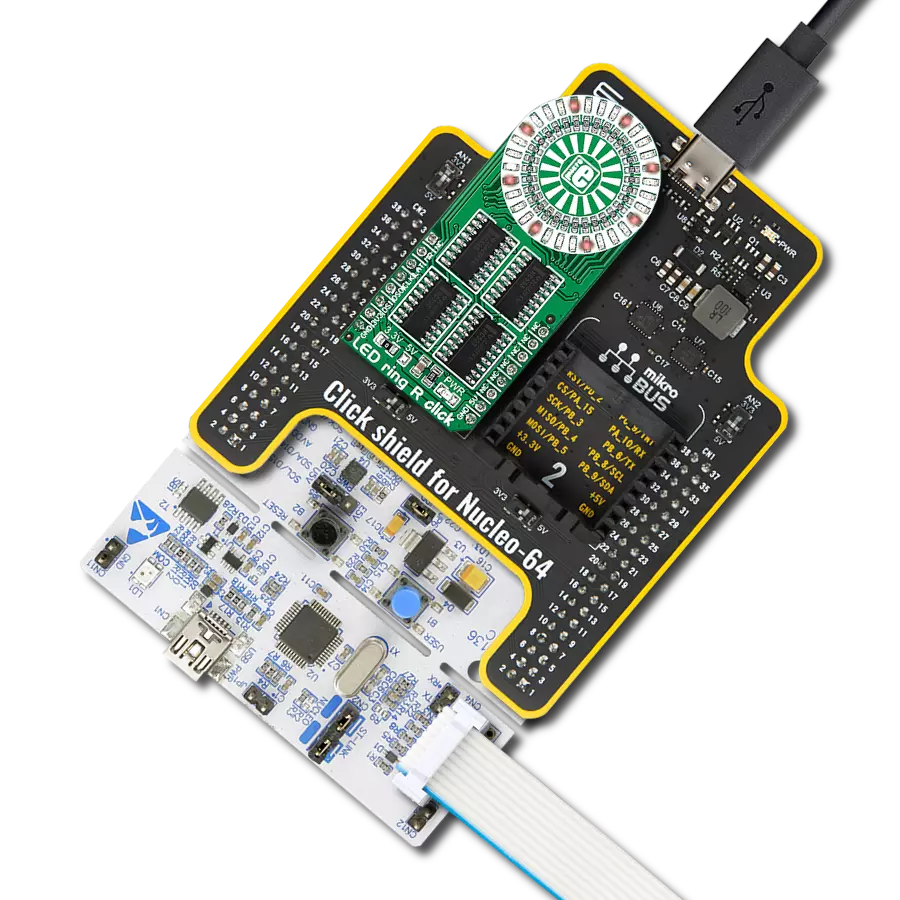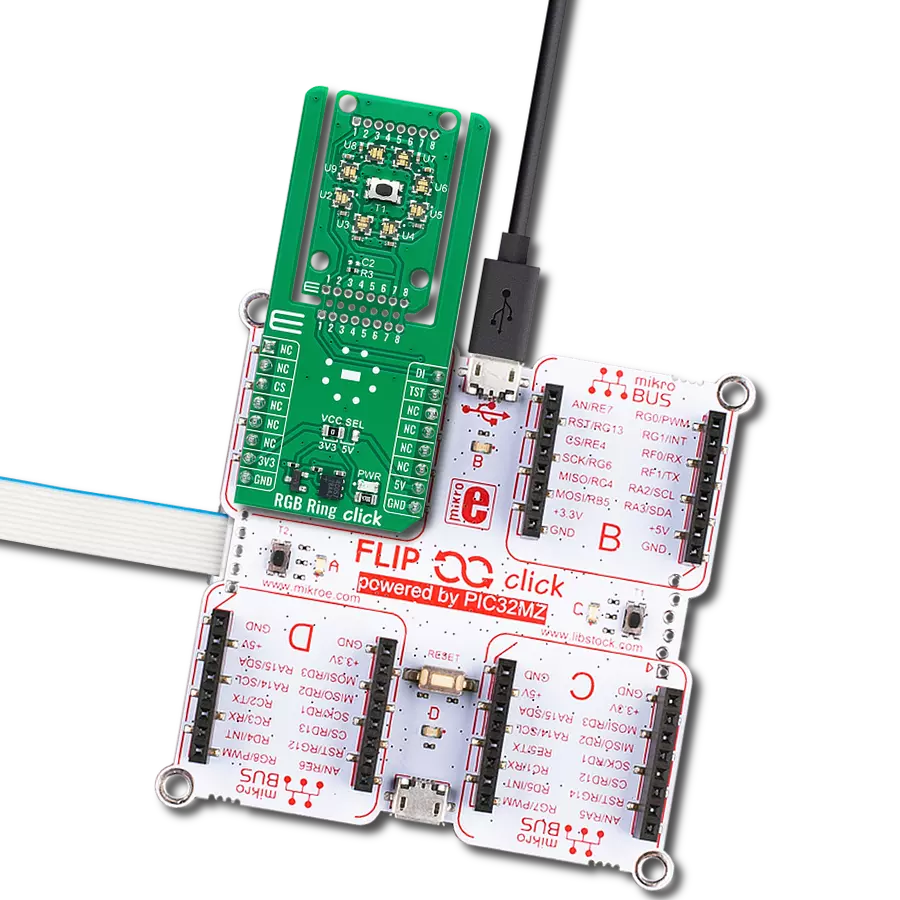Discover the simplicity and charm of early computing with 8800 Retro Click, an innovative tribute to the legendary Altair 8800
A
A
Hardware Overview
How does it work?
8800 Retro Click is based on the AS1115, a compact dot-matrix 8x8 LED driver from AMS-AG. It includes a 4-bit PWM for each segment and only one resistor for LED current adjustment (LED brightness). The AS1115 comprises an integrated BCD code-B/HEX decoder, multiplex scan circuitry, segment and display drivers, and 64-bit memory. Internal memory stores the shift register settings, eliminating the need for continuous device reprogramming. This board is ideal for seven-segment or dot matrix user interface displays and other white goods or personal electronic applications. The LED columns have common cathodes connected to the digit-drive lines,
where each of the 64 LEDs can be addressed separately. On initial Power-Up, the AS1115 registers are reset to their default values, the display is blanked, and the device goes into Shutdown mode. At this time, all registers should be programmed for Normal operation. The AS1115 features a low Shutdown current of typically 200nA and an operational current of typically 350μA. 8800 Retro Click communicates with MCU using a standard I2C 2-Wire interface, with a clock frequency of up to 1MHz in the Fast Mode Plus. In addition, the AS1115 can read back 16 buttons and offers a detailed short/open LED error diagnostic. Therefore, to get a valid readback of buttons, it is
recommended to read out the keyscan registers immediately after the IRQ interrupt pin, available on the INT pin of the mikroBUS™ socket, is triggered. In addition to the number-digits programming, this Click board™ can also be reset by software. This Click board™ can be operated only with a 3.3V logic voltage level. The board must perform appropriate logic voltage level conversion before using MCUs with different logic levels. Also, it comes equipped with a library containing functions and an example code that can be used as a reference for further development.
Features overview
Development board
Fusion for TIVA v8 is a development board specially designed for the needs of rapid development of embedded applications. It supports a wide range of microcontrollers, such as different 32-bit ARM® Cortex®-M based MCUs from Texas Instruments, regardless of their number of pins, and a broad set of unique functions, such as the first-ever embedded debugger/programmer over a WiFi network. The development board is well organized and designed so that the end-user has all the necessary elements, such as switches, buttons, indicators, connectors, and others, in one place. Thanks to innovative manufacturing technology, Fusion for TIVA v8 provides a fluid and immersive working experience, allowing access
anywhere and under any circumstances at any time. Each part of the Fusion for TIVA v8 development board contains the components necessary for the most efficient operation of the same board. An advanced integrated CODEGRIP programmer/debugger module offers many valuable programming/debugging options, including support for JTAG, SWD, and SWO Trace (Single Wire Output)), and seamless integration with the Mikroe software environment. Besides, it also includes a clean and regulated power supply module for the development board. It can use a wide range of external power sources, including a battery, an external 12V power supply, and a power source via the USB Type-C (USB-C) connector.
Communication options such as USB-UART, USB HOST/DEVICE, CAN (on the MCU card, if supported), and Ethernet is also included. In addition, it also has the well-established mikroBUS™ standard, a standardized socket for the MCU card (SiBRAIN standard), and two display options for the TFT board line of products and character-based LCD. Fusion for TIVA v8 is an integral part of the Mikroe ecosystem for rapid development. Natively supported by Mikroe software tools, it covers many aspects of prototyping and development thanks to a considerable number of different Click boards™ (over a thousand boards), the number of which is growing every day.
Microcontroller Overview
MCU Card / MCU
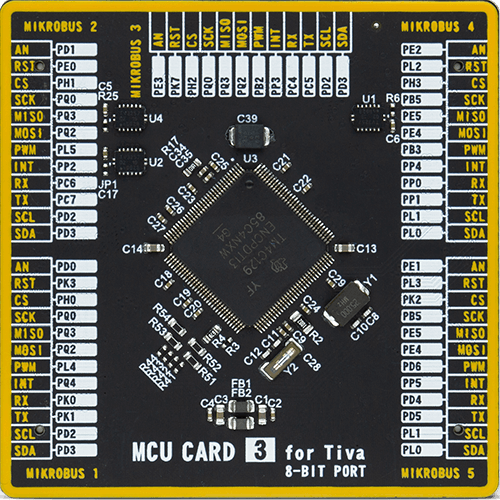
Type
8th Generation
Architecture
ARM Cortex-M4
MCU Memory (KB)
1024
Silicon Vendor
Texas Instruments
Pin count
128
RAM (Bytes)
262144
Used MCU Pins
mikroBUS™ mapper
Take a closer look
Click board™ Schematic

Step by step
Project assembly
Track your results in real time
Application Output
1. Application Output - In Debug mode, the 'Application Output' window enables real-time data monitoring, offering direct insight into execution results. Ensure proper data display by configuring the environment correctly using the provided tutorial.

2. UART Terminal - Use the UART Terminal to monitor data transmission via a USB to UART converter, allowing direct communication between the Click board™ and your development system. Configure the baud rate and other serial settings according to your project's requirements to ensure proper functionality. For step-by-step setup instructions, refer to the provided tutorial.

3. Plot Output - The Plot feature offers a powerful way to visualize real-time sensor data, enabling trend analysis, debugging, and comparison of multiple data points. To set it up correctly, follow the provided tutorial, which includes a step-by-step example of using the Plot feature to display Click board™ readings. To use the Plot feature in your code, use the function: plot(*insert_graph_name*, variable_name);. This is a general format, and it is up to the user to replace 'insert_graph_name' with the actual graph name and 'variable_name' with the parameter to be displayed.

Software Support
Library Description
This library contains API for 8800 Retro Click driver.
Key functions:
c8800retro_display_char- This function displays a single character from the predefined charset (IBM BIOS 8x8 font array)c8800retro_get_keypad- This function reads KEYA and KEYB registers and stores the register's inverted value to the keypad variablec8800retro_display_string- This function scrolls a desired string on LEDs.
Open Source
Code example
The complete application code and a ready-to-use project are available through the NECTO Studio Package Manager for direct installation in the NECTO Studio. The application code can also be found on the MIKROE GitHub account.
/*!
* @file main.c
* @brief 8800Retro Click example
*
* # Description
* This example demonstrates the use of 8800 Retro Click board.
*
* The demo application is composed of two sections :
*
* ## Application Init
* Initializes the driver and issues the Click default configuration,
* then asks the user to select the demo example using the on-board KeyPad.
*
* ## Application Task
* There are 4 different demo examples: KeyPad 4x4, Full charset, Text, and Image.
* This function will run the previously selected demo example in the loop.
* The user can always switch the example by pressing the button D4 three times in a row.
* In order to run the demo examples successfully, please follow the instructions logged
* on the USB UART.
*
* @author Stefan Filipovic
*
*/
#include "board.h"
#include "log.h"
#include "c8800retro.h"
/**
* @brief 8800 Retro Click demo example values.
* @details Enum values for demo examples selection.
*/
typedef enum
{
DEMO_KEYPAD4x4,
DEMO_FULL_CHARSET,
DEMO_TEXT,
DEMO_IMAGE,
} c8800retro_demo_example_t;
static c8800retro_t c8800retro;
static log_t logger;
static c8800retro_demo_example_t demo_example = DEMO_KEYPAD4x4;
uint8_t c8800retro_demo_string[ 9 ] = { ' ', 'M', 'i', 'k', 'r', 'o', 'E', ' ', 0 };
uint8_t c8800retro_demo_logo_mikroe[ 8 ] = { 0x7F, 0xFF, 0xC0, 0xFF, 0xFF, 0xC0, 0xFF, 0x7F };
/**
* @brief 8800 Retro select demo example function.
* @details This function asks the user to select the demo example via desired buttons.
* @param[in] ctx : Click context object.
* See #c8800retro_t object definition for detailed explanation.
* @return @li @c 0 - Success,
* @li @c -1 - Error.
*
* See #err_t definition for detailed explanation.
* @note Follow the procedure written on the USB UART to select the desired demo example.
*/
static err_t c8800retro_select_demo_example( c8800retro_t *ctx );
/**
* @brief 8800 Retro demo KeyPad 4x4 example function.
* @details This function executes the KeyPad 4x4 demo example.
* @param[in] ctx : Click context object.
* See #c8800retro_t object definition for detailed explanation.
* @return @li @c 0 - Success,
* @li @c -1 - Error.
*
* See #err_t definition for detailed explanation.
* @note Follow the procedure written on the USB UART to jump out the function.
*/
static err_t c8800retro_demo_keypad4x4( c8800retro_t *ctx );
/**
* @brief 8800 Retro demo Full charset example function.
* @details This function executes the Full charset demo example.
* @param[in] ctx : Click context object.
* See #c8800retro_t object definition for detailed explanation.
* @return @li @c 0 - Success,
* @li @c -1 - Error.
*
* See #err_t definition for detailed explanation.
* @note Follow the procedure written on the USB UART to jump out the function.
*/
static err_t c8800retro_demo_full_charset( c8800retro_t *ctx );
/**
* @brief 8800 Retro demo text example function.
* @details This function executes the Text demo example.
* @param[in] ctx : Click context object.
* See #c8800retro_t object definition for detailed explanation.
* @param[in] scroll_mode : @li @c 0 - Horizontal left.
* @li @c 1 - Horizontal right.
* @li @c 2 - Vertical up.
* @li @c 3 - Vertical down.
* @param[in] scroll_speed_ms : Scroll speed in miliseconds.
* @param[in] text : Text string (up to 32 characters).
* @return @li @c 0 - Success,
* @li @c -1 - Error.
*
* See #err_t definition for detailed explanation.
* @note Follow the procedure written on the USB UART to jump out the function.
*/
static err_t c8800retro_demo_text( c8800retro_t *ctx, uint8_t scroll_mode, uint16_t scroll_speed_ms, uint8_t *text );
/**
* @brief 8800 Retro demo image example function.
* @details This function executes the Image demo example.
* @param[in] ctx : Click context object.
* See #c8800retro_t object definition for detailed explanation.
* @param[in] p_image : Pointer to image buffer (array of 8 bytes).
* @return @li @c 0 - Success,
* @li @c -1 - Error.
*
* See #err_t definition for detailed explanation.
* @note Follow the procedure written on the USB UART to jump out the function.
*/
static err_t c8800retro_demo_image( c8800retro_t *ctx, uint8_t *p_image );
void application_init ( void )
{
log_cfg_t log_cfg; /**< Logger config object. */
c8800retro_cfg_t c8800retro_cfg; /**< Click config object. */
/**
* Logger initialization.
* Default baud rate: 115200
* Default log level: LOG_LEVEL_DEBUG
* @note If USB_UART_RX and USB_UART_TX
* are defined as HAL_PIN_NC, you will
* need to define them manually for log to work.
* See @b LOG_MAP_USB_UART macro definition for detailed explanation.
*/
LOG_MAP_USB_UART( log_cfg );
log_init( &logger, &log_cfg );
log_info( &logger, " Application Init " );
// Click initialization.
c8800retro_cfg_setup( &c8800retro_cfg );
C8800RETRO_MAP_MIKROBUS( c8800retro_cfg, MIKROBUS_1 );
err_t init_flag = c8800retro_init( &c8800retro, &c8800retro_cfg );
if ( I2C_MASTER_ERROR == init_flag )
{
log_error( &logger, " Application Init Error. " );
log_info( &logger, " Please, run program again... " );
for ( ; ; );
}
c8800retro_default_cfg( &c8800retro );
c8800retro_select_demo_example( &c8800retro );
}
void application_task ( void )
{
switch ( demo_example )
{
case DEMO_KEYPAD4x4:
{
c8800retro_demo_keypad4x4 ( &c8800retro );
break;
}
case DEMO_FULL_CHARSET:
{
c8800retro_demo_full_charset ( &c8800retro );
break;
}
case DEMO_TEXT:
{
c8800retro_demo_text ( &c8800retro, C8800RETRO_SCROLL_HORIZONTAL_LEFT,
C8800RETRO_SCROLL_SPEED_MEDIUM,
c8800retro_demo_string );
break;
}
case DEMO_IMAGE:
{
c8800retro_demo_image ( &c8800retro, c8800retro_demo_logo_mikroe );
break;
}
default:
{
break;
}
}
}
int main ( void )
{
/* Do not remove this line or clock might not be set correctly. */
#ifdef PREINIT_SUPPORTED
preinit();
#endif
application_init( );
for ( ; ; )
{
application_task( );
}
return 0;
}
static err_t c8800retro_select_demo_example( c8800retro_t *ctx )
{
err_t error_flag = c8800retro_clear_display( ctx );
error_flag |= c8800retro_clear_interrupt( ctx );
for ( ; ; )
{
uint16_t keypad = C8800RETRO_KEY_NONE;
log_printf( &logger, "\r\n Press one of the following buttons to select the demo example: \r\n" );
log_printf( &logger, " A1: KeyPad 4x4 \r\n" );
log_printf( &logger, " A2: Full charset \r\n" );
log_printf( &logger, " A3: Text \r\n" );
log_printf( &logger, " A4: Image \r\n" );
// Pressed button
while( c8800retro_get_int_pin( ctx ) );
error_flag |= c8800retro_get_keypad( ctx, &keypad );
while( !c8800retro_get_int_pin( ctx ) );
// Released button
while( c8800retro_get_int_pin( ctx ) );
error_flag |= c8800retro_clear_interrupt( ctx );
while( !c8800retro_get_int_pin( ctx ) );
switch ( keypad )
{
case C8800RETRO_KEY_A1:
{
demo_example = DEMO_KEYPAD4x4;
return error_flag;
}
case C8800RETRO_KEY_A2:
{
demo_example = DEMO_FULL_CHARSET;
return error_flag;
}
case C8800RETRO_KEY_A3:
{
demo_example = DEMO_TEXT;
return error_flag;
}
case C8800RETRO_KEY_A4:
{
demo_example = DEMO_IMAGE;
return error_flag;
}
default:
{
log_printf( &logger, " Wrong button! \r\n" );
break;
}
}
}
}
static err_t c8800retro_demo_keypad4x4( c8800retro_t *ctx )
{
log_printf( &logger, "\r\n ---- KeyPad 4x4 demo example ---- \r\n" );
log_printf( &logger, " Keypad layout: \r\n" );
log_printf( &logger, " 1 2 3 A \r\n" );
log_printf( &logger, " 4 5 6 B \r\n" );
log_printf( &logger, " 7 8 9 C \r\n" );
log_printf( &logger, " * 0 # D \r\n" );
log_printf( &logger, " Press the button D4 three times to switch the example \r\n " );
uint8_t d4_cnt = 0;
err_t error_flag = c8800retro_clear_display( ctx );
error_flag |= c8800retro_clear_interrupt( ctx );
for ( ; ; )
{
uint16_t keypad = C8800RETRO_KEY_NONE;
// Pressed button
while( c8800retro_get_int_pin( ctx ) );
error_flag |= c8800retro_get_keypad( ctx, &keypad );
while( !c8800retro_get_int_pin( ctx ) );
// Released button
while( c8800retro_get_int_pin( ctx ) );
error_flag |= c8800retro_clear_interrupt( ctx );
while( !c8800retro_get_int_pin( ctx ) );
if ( keypad & C8800RETRO_KEY_D4 )
{
d4_cnt++;
}
else
{
d4_cnt = 0;
}
switch ( keypad )
{
case C8800RETRO_KEY_A1:
{
error_flag |= c8800retro_display_char( ctx, '1' );
log_printf( &logger, "1" );
break;
}
case C8800RETRO_KEY_A2:
{
error_flag |= c8800retro_display_char( ctx, '2' );
log_printf( &logger, "2" );
break;
}
case C8800RETRO_KEY_A3:
{
error_flag |= c8800retro_display_char( ctx, '3' );
log_printf( &logger, "3" );
break;
}
case C8800RETRO_KEY_A4:
{
error_flag |= c8800retro_display_char( ctx, 'A' );
log_printf( &logger, "A" );
break;
}
case C8800RETRO_KEY_B1:
{
error_flag |= c8800retro_display_char( ctx, '4' );
log_printf( &logger, "4" );
break;
}
case C8800RETRO_KEY_B2:
{
error_flag |= c8800retro_display_char( ctx, '5' );
log_printf( &logger, "5" );
break;
}
case C8800RETRO_KEY_B3:
{
error_flag |= c8800retro_display_char( ctx, '6' );
log_printf( &logger, "6" );
break;
}
case C8800RETRO_KEY_B4:
{
error_flag |= c8800retro_display_char( ctx, 'B' );
log_printf( &logger, "B" );
break;
}
case C8800RETRO_KEY_C1:
{
error_flag |= c8800retro_display_char( ctx, '7' );
log_printf( &logger, "7" );
break;
}
case C8800RETRO_KEY_C2:
{
error_flag |= c8800retro_display_char( ctx, '8' );
log_printf( &logger, "8" );
break;
}
case C8800RETRO_KEY_C3:
{
error_flag |= c8800retro_display_char( ctx, '9' );
log_printf( &logger, "9" );
break;
}
case C8800RETRO_KEY_C4:
{
error_flag |= c8800retro_display_char( ctx, 'C' );
log_printf( &logger, "C" );
break;
}
case C8800RETRO_KEY_D1:
{
error_flag |= c8800retro_display_char( ctx, '*' );
log_printf( &logger, "*" );
break;
}
case C8800RETRO_KEY_D2:
{
error_flag |= c8800retro_display_char( ctx, '0' );
log_printf( &logger, "0" );
break;
}
case C8800RETRO_KEY_D3:
{
error_flag |= c8800retro_display_char( ctx, '#' );
log_printf( &logger, "#" );
break;
}
case C8800RETRO_KEY_D4:
{
error_flag |= c8800retro_display_char( ctx, 'D' );
log_printf( &logger, "D" );
break;
}
default:
{
break;
}
}
if ( d4_cnt == 3 )
{
error_flag |= c8800retro_select_demo_example( ctx );
return error_flag;
}
}
return error_flag;
}
static err_t c8800retro_demo_full_charset( c8800retro_t *ctx )
{
log_printf( &logger, "\r\n ---- Full charset demo example ---- \r\n" );
log_printf( &logger, " Press the button D4 three times to switch the example \r\n" );
err_t error_flag = c8800retro_clear_display( ctx );
error_flag |= c8800retro_clear_interrupt( ctx );
for ( ; ; )
{
for ( uint8_t cnt = 0; cnt <= 255; cnt++ )
{
if ( cnt == 128 )
{
cnt = 160;
}
error_flag |= c8800retro_display_char( ctx, cnt );
Delay_ms ( 200 );
if ( !c8800retro_get_int_pin( ctx ) )
{
uint16_t keypad = C8800RETRO_KEY_NONE;
uint8_t d4_cnt = 0;
while ( d4_cnt < 3 )
{
// Pressed button
while( c8800retro_get_int_pin( ctx ) );
error_flag |= c8800retro_get_keypad( ctx, &keypad );
while( !c8800retro_get_int_pin( ctx ) );
// Released button
while( c8800retro_get_int_pin( ctx ) );
error_flag |= c8800retro_clear_interrupt( ctx );
while( !c8800retro_get_int_pin( ctx ) );
if ( ( keypad & C8800RETRO_KEY_D4 ) != C8800RETRO_KEY_D4 )
{
break;
}
d4_cnt++;
}
if ( d4_cnt == 3 )
{
error_flag |= c8800retro_select_demo_example( ctx );
return error_flag;
}
}
if ( C8800RETRO_ERROR == error_flag )
{
log_printf( &logger, "\r\n Error occured. \r\n" );
return error_flag;
}
}
}
}
static err_t c8800retro_demo_text( c8800retro_t *ctx, uint8_t scroll_mode, uint16_t scroll_speed_ms, uint8_t *text )
{
log_printf( &logger, "\r\n ---- Text demo example ---- \r\n" );
log_printf( &logger, " Once it finish scrolling, press the button D4 three times in the next" );
log_printf( &logger, " 3 seconds to switch the example \r\n" );
err_t error_flag = c8800retro_clear_display( ctx );
error_flag |= c8800retro_clear_interrupt( ctx );
for ( ; ; )
{
uint16_t timeout = 3000;
log_printf( &logger, "\r\n Text scrolling has started. \r\n" );
error_flag |= c8800retro_display_string( ctx, scroll_mode, scroll_speed_ms, text );
error_flag |= c8800retro_clear_interrupt( ctx );
log_printf( &logger, "\r\n Text scrolling has finished. Press the button D4 three times in the next" );
log_printf( &logger, " 3 seconds to switch the example. Otherwise, scrolling will start over. \r\n" );
while ( timeout-- > 0 )
{
if ( !c8800retro_get_int_pin( ctx ) )
{
uint16_t keypad = C8800RETRO_KEY_NONE;
uint8_t d4_cnt = 0;
while ( d4_cnt < 3 )
{
// Pressed button
while( c8800retro_get_int_pin( ctx ) );
error_flag |= c8800retro_get_keypad( ctx, &keypad );
while( !c8800retro_get_int_pin( ctx ) );
// Released button
while( c8800retro_get_int_pin( ctx ) );
error_flag |= c8800retro_clear_interrupt( ctx );
while( !c8800retro_get_int_pin( ctx ) );
if ( ( keypad & C8800RETRO_KEY_D4 ) != C8800RETRO_KEY_D4 )
{
break;
}
d4_cnt++;
}
if ( d4_cnt == 3 )
{
error_flag |= c8800retro_select_demo_example( ctx );
return error_flag;
}
}
Delay_ms ( 1 );
}
if ( C8800RETRO_ERROR == error_flag )
{
log_printf( &logger, "\r\n Error occured. \r\n" );
return error_flag;
}
}
}
static err_t c8800retro_demo_image( c8800retro_t *ctx, uint8_t *p_image )
{
log_printf( &logger, "\r\n ---- Image demo example ---- \r\n" );
log_printf( &logger, " Press the button D4 three times to switch the example \r\n" );
err_t error_flag = c8800retro_clear_display( ctx );
error_flag |= c8800retro_clear_interrupt( ctx );
error_flag |= c8800retro_display_image( ctx, p_image );
for ( ; ; )
{
if ( !c8800retro_get_int_pin( ctx ) )
{
uint16_t keypad = C8800RETRO_KEY_NONE;
uint8_t d4_cnt = 0;
while ( d4_cnt < 3 )
{
// Pressed button
while( c8800retro_get_int_pin( ctx ) );
error_flag |= c8800retro_get_keypad( ctx, &keypad );
while( !c8800retro_get_int_pin( ctx ) );
// Released button
while( c8800retro_get_int_pin( ctx ) );
error_flag |= c8800retro_clear_interrupt( ctx );
while( !c8800retro_get_int_pin( ctx ) );
if ( ( keypad & C8800RETRO_KEY_D4 ) != C8800RETRO_KEY_D4 )
{
break;
}
d4_cnt++;
}
if ( d4_cnt == 3 )
{
error_flag |= c8800retro_select_demo_example( ctx );
return error_flag;
}
}
if ( C8800RETRO_ERROR == error_flag )
{
log_printf( &logger, "\r\n Error occured. \r\n" );
return error_flag;
}
}
}
// ------------------------------------------------------------------------ END
